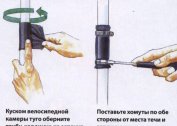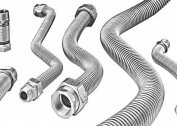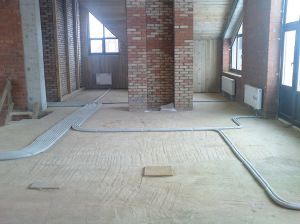
The effectiveness of the heating system depends on many factors. These include materials for the manufacture of pipes and devices, a correctly selected boiler, and a professionally designed circuit for laying a trunk. The latter affects not only the quality of work, but also safety and durability. For country cottages with a large area, the do-it-yourself radiant heating system of a private house is most often used. What is its feature and why is it more effective than standard pipe routing?
Beam heating circuit
Traditionally, pipes are laid along the walls. However, this technique is unacceptable for houses with a large area and several floors. The main disadvantage is the quick cooling of the coolant. The radiological heating system of a two-story house with the distribution of hot water on individual circuits can solve this problem. But first you need to find out what a radiant heating system is - photos and videos will help in this.
The design principle is to create separate circuits, each of which is connected to one or more devices (radiator, floor heating, etc.). In this case, the piping is done not on the wall, but on the floor. A properly installed do-it-yourself radiant heating system has several advantages:
- Uniform distribution of the heat carrier on all devices. In fact, there is no temperature difference, as with a serial connection - the farther the radiator from the boiler, the lower the water temperature in it;
- The ability to adjust the heating level in each individual circuit. To do this, install a two-way (three-way) valve;
- Radial heating distribution makes it possible to carry out repair or maintenance work without shutting down the entire system;
- Decrease in hydraulic losses. This is due to the fact that the pipes are laid with a minimum number of corner joints.
However, the radial layout of radiator heating also has drawbacks. Firstly, it can only be two-pipe. The cooled coolant is necessary for mixing with the hot stream in order to minimize the cost of heating the water and automatically adjust its temperature. If the return pipe will pass separately from the main ones, it will be practically impossible to install the mixing unit.
The opinion about the greatly increased consumption of materials for installation is erroneous. If you correctly draw up a pipe laying diagram, then it turns out that the beam wiring of the heating system will in some cases be more economical.
To do this, you need to correctly approach the issue of creating preliminary design documentation.
Do-it-yourself radiant heating

Is it possible to make a professional drawing of a radiant heating system of a two-story house? This is quite realistic if you apply an integrated approach to solving this problem. This will require initial design skills (creating elementary drawings), knowledge of the basics of heating. If there is no self-confidence, it is recommended to contact specialized design companies.
For those who want to make a radiation system for heating a private house with their own hands, the work should be divided into several stages:
-
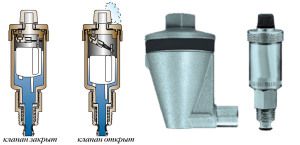 Mayevsky crane (air vent)
Mayevsky crane (air vent)Analysis of the condition of the room. The main condition for laying pipes is the lack of a finishing floor. It can be equipped only after laying highways.
- Radiator Mounting Locations. Their installation is recommended on the outer walls under the window structures, since here the biggest heat loss.
- House Planning. It first marks the initial data necessary for a two-pipe beam heating system - the location of the boiler and radiators.
- The plan indicates the laying of pipelines. For a two-story house, it is first planned to install a central distribution manifold, to which individual circuits will be connected.
- Shut-off and safety equipment. The radiant heating circuit must have safety groups and shutoff valves. These include Mayevsky taps (air vents), pressure gauges, thermometers, floor taps and manifolds. Their installation order must be indicated on the diagram.
The last point is very important, since for a standard pipe routing it is enough to install one air vent. In our case, their number should be equal to the number of circuits in the system. This is necessary so that the radiant heating system of a private house works normally, without the occurrence of air jams. Mayevsky crane is installed at the highest point of the circuit. Usually this is the upper radiator pipe.
Collector or beam pipe routing
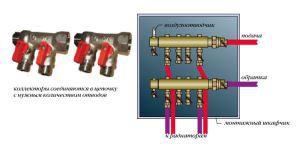
The main element of the system, without which radiation heating of the house is impossible, is the collector. It is designed to distribute the coolant from the central highway to individual circuits. Externally, the collector is a hollow cylinder with a pipe for water inlet (outlet) and connecting elements to which the system circuits are connected.
In order for a two-pipe radiant heating system to function normally, two types of collectors will be required:
- Input. For optimal operation, it is equipped with a pump and a two-way (three-way) control valve. For the latter to function, you need a thermometer installed in the collector body. Receiving from it the values of the current water temperature in the radial distribution of the heating, the valve mixes the hot and cooled coolant. Thus, automatic regulation of heat in the pipes occurs.
- Output. After the liquid has gone through a complete cycle along the contours, it must again return to the boiler for further heating. To collect it, an output collector is installed. On its nozzles, you can put additional control devices - balancing flow meters. With their help, the water temperature of each circuit in the radial layout of the radiator heating can be changed by adjusting the throughput of the pipes.
At first glance, when designing a system, you can do without a collector by simply making a distribution using tees. However, in this case, the radiation wiring of the heating system will experience malfunctions. Without pumps, distribution and control mechanisms, there is the possibility of “downtime” of some circuits - the coolant simply will not circulate in them.
Pipes: material requirements
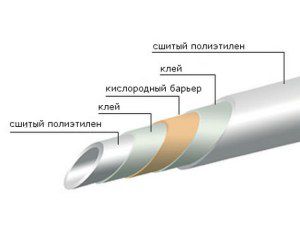
What pipes are recommended to choose when installing a radiant heating system with your own hands? There are several criteria that determine the operational and technical qualities of a future highway. The starting point can be considered the installation conditions - the pipes are mounted in a cement screed or under a decorative coating of a wooden floor.
The specifics of laying such a line is the need for bending pipes, the angles of which are most often not equal to standard ones. Therefore, it is recommended to use a sufficiently flexible material to avoid a large number of joints. Cross-linked polyethylene is best suited for a radiant heating system for a private house.
A cross-linked polyethylene pipe should have an airtight interlayer.
This is a prerequisite, since without it, polyethylene will allow air molecules to enrich the coolant. As a result of this, the rusting process will progress on the inner surface of the radiators and the heat exchanger of the boiler. The material of manufacture must be indicated on the radiant heating circuit.
In addition, when choosing pipes, you need to pay attention to such factors:
- Collector wiring is characterized by the use of pipes for circuits of smaller diameter than the cross section of a common supply pipe. The optimal size will be 32 or 24 mm;
- Providing protection against mechanical stress. Radiation heating pipes of the house, laid on the floor, are poured with a cement screed. During this, you need to ensure that there is no crushing of the highway.
When installing a radiant heating system for a private house, only on our own is the integrity and correctness of the pipe connection checked before pouring the screed. To do this, after installing all the elements, the heating boiler is started. In the process of fluid circulation along the lines there should be no leaks. Only at the end of such a check can a decorative floor be equipped.
Beam Installation Tips
Unlike the standard installation scheme, the installation of a radiant heating system for a two-story house has a number of nuances. First of all, this concerns the mounting location of the control manifolds. The common distribution unit must be located immediately after the coolant exits the boiler. Most often this is a specially equipped boiler room.
If the house is large enough, then there may be several distribution collectors. For a two-pipe heating system with a radiation configuration, it is important that the user has free access to each of them. Therefore, they are installed in a special closed box.
Do not leave the collector in a cement screed or hide it behind fixed panels.
To ensure control of the operation of the radial distribution system of heat supply, sensors and shutoff valves are installed:
- Manometers and thermometers. At least one pair of these devices must be at the outlet of the hot fluid from the boiler. It is also recommended that they be mounted on each collector. In this way, you can visually control the level of water heating in the radial heating distribution for each radiator (or group) separately. This is one of the basic rules for organizing a radiant heating system in-house;
- Protective fittings. It includes Mayevsky air cranes and safety valves to stabilize the pressure;
- Stop valves. It is installed in front of the boiler inlet pipe and for each collector separately. With their help, it is possible to carry out repair or maintenance work with the radial distribution of heating without disconnecting all circuits. It is enough to limit the flow of coolant to a specific one.
Currently, the use of a radiant heating system for a private house is the best option. But only if standard installation is not possible due to low efficiency. Therefore, you must first calculate two options. This can be done using special programs, for example - Valtec, Oventrop CO or Kan CO.
For a better understanding of the practical side of the installation of a radiant heating system, photos are not entirely suitable. Therefore, it is recommended to familiarize yourself with the video material, which explains the specifics of installing collectors and connecting pipelines to them:
